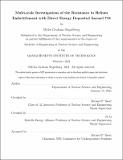Multi-scale investigations of the Resistance to helium embrittlement with Direct Energy Deposited Inconel 718
Author(s)
Stapelberg, Myles Graham.
Download1256665509-MIT.pdf (16.38Mb)
Other Contributors
Massachusetts Institute of Technology. Department of Nuclear Science and Engineering.
Advisor
Michael P. Short and Ju Li.
Terms of use
Metadata
Show full item recordAbstract
To address the high levels of helium production in advanced fission and fusion reactors, in an economical manner, Direct Energy Deposition (DED) was utilized with the existing alloy, Inconel 718. Based on previous works with DED and laser welding, it was hypothesized that nano-sized pores could be engineered within the matrix of the sample to maximize the number of available sinks for helium bubbles to migrate towards, instead of migrating towards grain boundaries. A sparse experimental matrix with 316L Stainless Steel, followed up with 2-Factor, 3 Level full factorial experiments with Inconel 718 was conducted to understand the input parameters for engineering nanoporosity. In-situ ion irradiation TEM was conducted to analyze the helium bubble kinetics in real time at the nanoscale and ex-situ ion irradiation followed by Vicker's microhardness tests, X-ray Diffraction, Energy Dispersion Spectroscopy, and Focused Ion Beam Analysis were conducted to gauge the effectiveness of the printed sample at inhibiting helium migration and embrittlement. Due to insufficient measurements and the sensitivity of Inconel 718's microstructure to temperature, no significant change between the control and helium implanted specimens were observed at the micro scale. However, at the nanoscale, nanopores were found and were able to suppress the nucleation of helium bubbles. As such, a followup study, investigating nuisance factors discussed in this work is warranted to better assert whether or not DED can effectively reduce the effects of helium embrittlement.
Description
Thesis: S.B., Massachusetts Institute of Technology, Department of Nuclear Science and Engineering, February, 2021 Cataloged from the official PDF of thesis. Includes bibliographical references (pages 101-114).
Date issued
2021Department
Massachusetts Institute of Technology. Department of Nuclear Science and EngineeringPublisher
Massachusetts Institute of Technology
Keywords
Nuclear Science and Engineering.